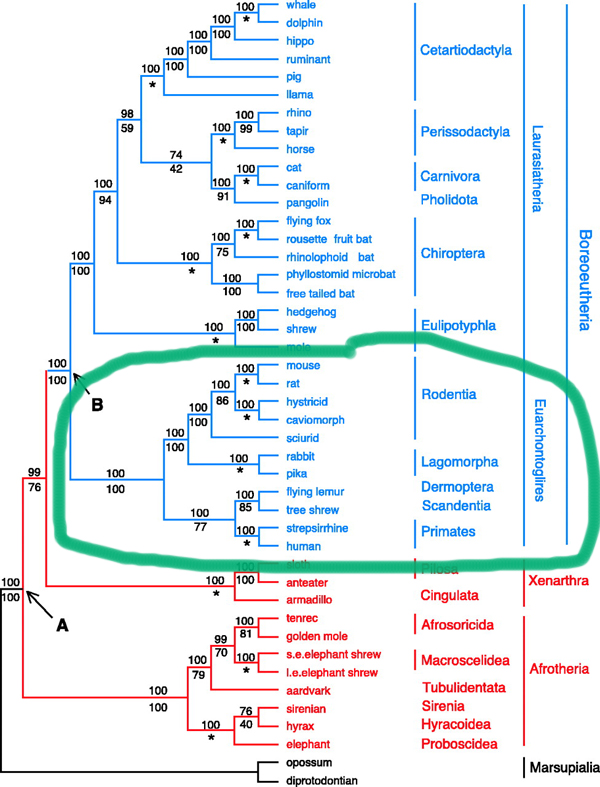

The superorder Euarchontaglires is comprised of five orders:
- Rodentia
- Lagomorpha
- Dermoptera
- Scandentia
- Primates
I. Order Rodentia - mice, kangaroo rats, porcupines, squirrels, etc.
- Most notable characteristic: Teeth
- Rootless
- Incisors
- Cheek teeth
- Diastema
- Complex muscles to control chewing and gnawing
- Convergence with other eutherian mammals
II. Order Lagomorpha - rabbits, hares, and pikas
- Characteristics related to diet
- Teeth
- Incisors
- No canines
- Cheek teeth - lower jaw narrower than upper jaw
- Characteristics related to quadrupedal saltatory locomotion
- Digitigrade/ plantigrade
- Skull
- Fenestration
- Jointed
- Lagomorph? Artiodactyl?
III. Order Dermoptera - flying lemurs
Name means "skin wing"
- Adaptations associated with locomotion
- Patagium most complete of any mammal
- Best gliders of all mammals
IV. Order Scandentia - tree shrews
- Characteristics of the order
- Once considered a primitive primate, then lumped with Insectivora, now considered closely related to Primates and Dermopterans
- Look like squirrels (long furry tails)
- Teeth resemble insectivores somewhat (caniform incisor, reduced canine)
- Important differences between tree shrews and insectivores:
- Complete zygomatic arch
- Has auditory bullae
- Big brain case for its size
- Has a cecum
- Tree shrews - one cool thing!
- Young left in a separate nest
- Nursed once/48 h
- Weaned in a month
V. Order Primates
- General characteristics (adaptations for arboreality?) - None are unique to primates!
- Locomotion
- Pentadactyly
- Nails in stead of claws (unguiculate)
- Prehensility of hands and feet
- Traction ridges on tips of digits
- Tendency towards erectness of posture
- Teeth and diet
- Generalized teeth (bunodont molars)
- Generalized diet
- Brain and behavior
- More reliance on vision (forward facing eyes, binocular, stereoscopic, most have color vision)
- Reduction of snout
- Big, complex brains (especially cerebral cortex)
- Flexibility of behavior
- In many species, complex social organization
- Living primates
- Suborder Strepsirhini - Prosimians (lemur, galago, loris)
- General characteristics
- ancestral morphology and possibly behavior (mostly nocturnal, relies on sense of smell)
- restricted geographical range (Old World, many restricted to Madagascar)
- rhinarium
- toothcomb and toilet claw
- tapetum lucidum
- bicornuate uterus
- One cool thing! The aye-aye
- Suborder Haplorhini
- Characteristics that distinguish them from the Strepsirhini
- lack rhinarium
- Reduced rostrum (more reliance on vision, less on smell)
- spatulate incisors
- simplex uterus
- Major groups
tarsiers, platyrrhini (New World) and catarrhini (Old World)
- Trivia! Is it the right monkey?
- Family Tarsiidae (tarsiers) - phylogenetic relationships very unclear until recently
More great photos and videos of primates:


